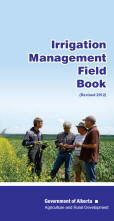Irrigation Scheduling for Crops in Southern Alberta
Irrigation management is about
controlling the rate, amount, and timing of applied
irrigation water in a planned and efficient manner.
The purpose of irrigation management is to
effectively use available irrigation water in
managing and controlling the soil moisture
environment of crops to promote the desired crop
response, to minimize soil degradation, and to
protect water quality. Proper irrigation management
requires a good understanding of soil properties,
soil-water-plant relationships, crop type and
sensitivity to drought stress, crop growth stages,
availability of a water supply, and climatic factors
that affect crop water use such as rainfall,
temperature, humidity, and net radiation. Equipped
with this knowledge, an irrigator can develop a
workable and efficient irrigation scheduling
program.
Our irrigation management philosophy is to use
available water efficiently to meet crop water
requirements for maximum water productivity by
utilizing crop-specific irrigation management
strategies. Generally, the goal is to ensure that
water is available at germination and early
development by applying light, frequent irrigations
(if there is no rainfall) for vigorous growth, and
to replenish and increase available soil water
content in the entire root zone during pre-flowering
growth stages to allow irrigation systems to keep up
to crop demand during the peak water use period,
which typically occurs during flowering and
fruit-formation growth stages. Crop-specific
irrigation management strategies are usually applied
to adjust for differences among crops in their
effective root zones, sensitivity to water stress,
types (cool verses warm season), vulnerability to
diseases at various crop growth stages, soil
fertility levels, plant population, physiologic
maturity (timing of last irrigation), and potential
income. Reports
The
Alberta Irrigation Management
Model (AIMM) is a decision support tool
software package that assists irrigation producers
with their irrigation scheduling decisions. The AIMM
software runs as a Windows based program and has a
agronomic record keeping component incorporated into
the program as well. AIMM acquires the climate
parameters required to calculate Evapotranspiration
(ET) and irrigation recommendations from the
AIMM website.
Producers simply choose the station that is closest
to their irrigation field from any of the current
climate stations on-line.

The Irrigation Scheduler Mobile is a free irrigation scheduling tool developed by Washington State University that is designed for use on a smart phone or on a desktop web browser for doing simplified check-book style irrigation scheduling. It uses tables of default crop and soil parameters, and automatically pulls daily crop water use (evapotranspiration, or ET) estimates from Alberta's Irrigation Management Climate Information Network (IMCIN). It works as a native app (Google Play and Apple App Store), a web app, and as a stand alone
website for access from anywhere. To use the mobile irrigation scheduler you must have an AgWeatherNet user name and password.

The objective for publishing the Alberta Irrigation Management Manual is to provide current information on beneficial irrigation management practices for optimum production of large acre irrigated crops in Alberta.

The
Alberta Agriculture Irrigation Management Field Book
is used in the Irrigation Management training
program. It provides a convenient way to record
annual crop and irrigation related data and includes
information concerning crop water use, and how to
determine soil moisture. the Irrigation Management training
program. It provides a convenient way to record
annual crop and irrigation related data and includes
information concerning crop water use, and how to
determine soil moisture.
The booklets are available free of
charge from any Irrigation Management Branch office.
Offices are located in Brooks and Lethbridge.
For more information call:
- Brooks 403-362-1343
- Lethbridge 403-381-5532
|